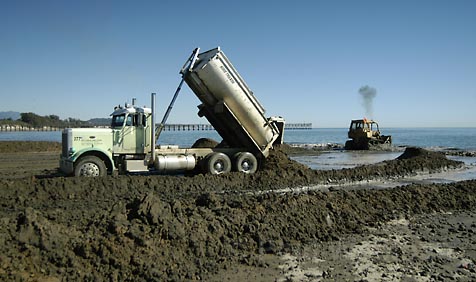Supes Take Major Step Toward Goleta Beach Solution
Stop That Sand

When you build a county park along an ever-shifting stretch of sand that abuts an also shifting slough, you’d better have a plan for protecting this park against the forces of nature, especially during the winter months when the Pacific Ocean threatens to carry it out to sea. Since 1998, Santa Barbara County has been at a loss for what to do about Goleta Beach. Drawing about 1.4 million visitors a year, Goleta Beach is easily the county’s most popular park. While a series of rock walls and several sand dredges and dumps have more or less preserved the 29-acre park, the slow, steady, seasonal erosion of sand has been a driving issue of concern behind dozens of public hearings on how best to preserve Goleta Beach.
This week, with the screws put to them by the California Coastal Commission-the state agency that has repeatedly reissued the emergency permits to install temporary erosion-fighting structures, such as the rock walls-county supervisors unanimously approved a plan that looks to save Goleta Beach through the construction of permeable steel pilings along the existing pier designed to slow sand flow, and the strategic deployment of some 500,000 cubic yards of sand to either side of the pier.
With their vote, supervisors chose the middle ground between a more earth-friendly “managed retreat” plan of protection and a decidedly more earth-damaging approach that called for beefed up coastal armor-more rock walls, for example. But much to the consternation of both the Santa Barbara Surfrider Foundation and the Environmental Defense Center, the supervisors decided to pass the Goleta Beach hot potato along to the Coastal Commission and voted to file for a permit without finalizing a local level environmental review of the project-a decision that many feel is dubious given the debatable nature of any erosion control device’s effectiveness.
According to Chris Webb-a representative for the plan’s designer, Mowatt and Nichols Engineering-the permeable pilings plus the sand will, within 10 years, be “highly successful” in stopping the Goleta Beach erosion problem without nasty side effects. Testifying before the Board of Supervisors on January 22, Webb said, “The beauty of this project is that there will be no down-shore impacts from it.” Based on computer modeling and historical sand behavior at places like Santa Monica Bay, the plan calls for the construction of steel pilings along the pier’s south side extending 500 feet from shore and capped by a lateral extension of the pier. This, theoretically, will create a maze through which the ocean water will pass more slowly.
But the magic of the plan comes from the placement of two types of sand mounds, called “salients” and “fillets,” on either side of the pier. The hope is that once the half million or so cubic yards of sand spends a few years intimately dancing with local currents, seasonal storms, and tidal cycles, it will form a sort of ridge that ribbons its way from a high point north of the pier to a low point south of the pier. This will allow enough sand to flow southward to continue to feed beaches like those along More Mesa, and the ridge might also form a sandbar of sorts to further protect Goleta Beach sand by breaking up wave action before it comes ashore.
Summarizing skepticism about the sand flow forecast, Valerie Olson, who has attended most of the Goleta Beach working group hearings over the past several years, cautioned supervisors: “Sometimes innovative things turn out to be terribly expensive and terribly wrong innovative things.” According to county staff, the pilings proposal will cost approximately $9.7 million over the next 20 years, on top of some $3 million already spent during the planning stages.
EDC environmental analyst Brian Trautwein, after testifying that he has extensive evidence indicating possible negative impacts of piling devices, urged the supervisors to file for an extension in the permitting process from the Coastal Commission so that the EIR, stalled in the draft stage since July, could be completed before taking the next step. “This is about process. This is about whether or not the county will move forward with a project without ever completing the local process : It doesn’t look right and it is unprecedented in this county,” he said.
Echoing Trautwein’s concerns was 2nd District Supervisor Janet Wolf, who sternly asked county counsel and staff for an explanation of what happened with the EIR. Upon receiving assurances that the Coastal Commission would weigh in on that debate and that the county supervisors also would have an additional hearing on the subject before it was put into action, Wolf seemed satisfied and motioned to approve the plan. The California Coastal Commission is expected to hear the permit application sometime this spring.



